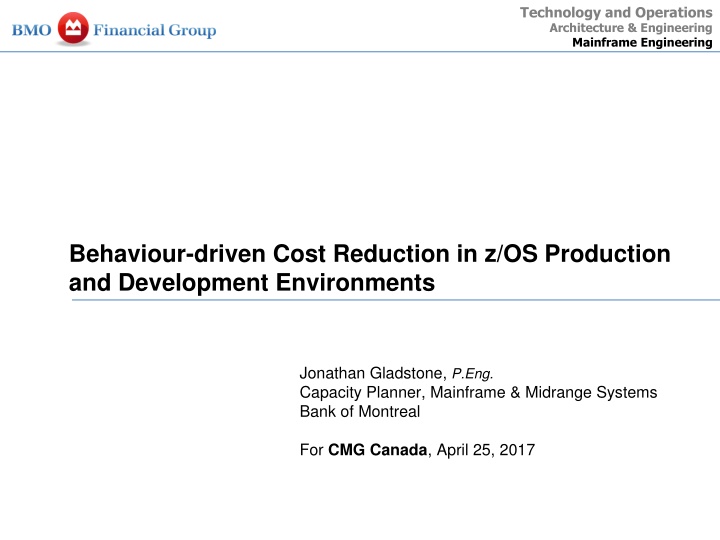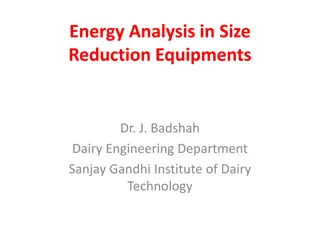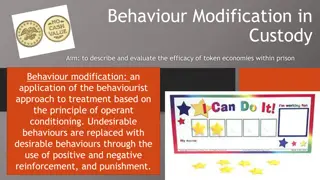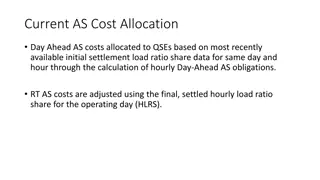
Mainframe Engineering for Cost Reduction in z/OS Environments
Learn about Jonathan Gladstone, a capacity planner at the Bank of Montreal, who shares insights on behavior-driven cost reduction strategies in z/OS production and development environments. Discover topics such as WLM profiles, prioritizing workloads, utilizing zIIPs, licensing strategies, soft capping, and more. Gain valuable knowledge on maximizing mainframe efficiency and reducing costs effectively.
Download Presentation

Please find below an Image/Link to download the presentation.
The content on the website is provided AS IS for your information and personal use only. It may not be sold, licensed, or shared on other websites without obtaining consent from the author. If you encounter any issues during the download, it is possible that the publisher has removed the file from their server.
You are allowed to download the files provided on this website for personal or commercial use, subject to the condition that they are used lawfully. All files are the property of their respective owners.
The content on the website is provided AS IS for your information and personal use only. It may not be sold, licensed, or shared on other websites without obtaining consent from the author.
E N D
Presentation Transcript
Technology and Operations Architecture & Engineering Mainframe Engineering Behaviour-driven Cost Reduction in z/OS Production and Development Environments Jonathan Gladstone, P.Eng. Capacity Planner, Mainframe & Midrange Systems Bank of Montreal For CMG Canada, April 25, 2017
Technology and Operations Architecture & Engineering Mainframe Engineering Who is this guy, and what s this all about? Jonathan Gladstone is a senior information systems professional, educator, planner and team leader with almost thirty years of experience in capacity management, project initiation, business continuity management, change & problem management and ITIL process development & implementation for large corporate I/T infrastructures. He is currently the capacity planner for mainframe and mid-range systems at the Bank of Montreal, and a part-time professor of Computer Studies at Georgian College. Presentation Abstract: At the Bank of Montreal, we ve made strong use of available means to control mainframe costs, with great results. We re careful with our WLM profiles, we make sure our internal customers understand the cost of mainframe utilization, we were early adopters of zAAPs and zIIPs, and we use soft-capping to maximize value in our Development environment. We can t share a lot of detail, of course, but in this short discussion we ll review how some of those initiatives have helped us keep our mainframe cost per unit of capacity dropping over the years. Apr. 25, 2017 Behaviour-driven Cost Reduction in z/OS Production and Development Environments - J.Gladstone 2
Technology and Operations Architecture & Engineering Mainframe Engineering Topics WLM profiles Prioritize your workloads Use of zIIPs Know your products Use of licensing PSLC, CMP Know your vendors Soft caps Know your tools Cross-charging Inform your customers Apr. 25, 2017 Behaviour-driven Cost Reduction in z/OS Production and Development Environments - J.Gladstone 3
Technology and Operations Architecture & Engineering Mainframe Engineering WLM profiles prioritize your workloads In mainframes, dozens or hundreds of heterogeneous workloads (thousands of tasks) run together in a single system image. System images run in logical partitions (LPARs), which are containers of virtual resources. Yes, just like distributed! Or really, vice versa mainframes have done this since the 1970s Groups of system images are clustered together across disparate physical footprints (sometimes at multiple sites) into Parallel Systems Complexes (parallel Sysplexes), with locking and serialization managed by Coupling Facilities Not so much like distributed, but similar constructs exist Workload Manager (WLM) prioritizes the many heterogeneous workloads across all of the systems in a given Sysplex with various classes and targets for batch and online workloads WLM can manage memory and I/O access too, using the same prioritization Careful use of WLM prioritization allows very high utilizations We use a threshold of 90% in our Production mainframes Apr. 25, 2017 Behaviour-driven Cost Reduction in z/OS Production and Development Environments - J.Gladstone 4
Technology and Operations Architecture & Engineering Mainframe Engineering Use of zIIPs know your products configuration choices Customers can enable up to 141 engines on a current-generation z13 footprint That s a lot of processing power! For comparative purposes, one engine can run anywhere from four or five to fifteen or twenty production Linux images, depending on workload. General-purpose engines are expensive but wait! zIIP specialty engines are physically identical the same engines with a different label that can run a significant subset of the work for much lower cost. GCP hardware costs well over C$500k for hardware, and usually a lot more again for software. zIIP hardware costs less than C$100k, with no software cost. Add shared infrastructure costs (box, memory, crypto, I/O ), cost ratio is about one-sixth per unit of utilization Apr. 25, 2017 Behaviour-driven Cost Reduction in z/OS Production and Development Environments - J.Gladstone 5
Technology and Operations Architecture & Engineering Mainframe Engineering Use of licensing know your vendors offerings Vendors offer a plethora of licensing methods pick the right ones! We ll focus on IBM here mainframe z/OS enterprises use a lot of theirs So for IBM mainframes, z/OS LPARs If you re using parallel sysplex, chances are you want either PSLC or CMP Parallel Sysplex License Charge (PSLC) can reduce costs by 5+% for select products (including z/OS, DB2, CICS, IMS and many others) allows customers to pay a single software charge per product based on monthly utilization, and for a single sysplex per box as long as that sysplex has a system using over 50% of each given box; pay based on peak four-hour rolling average (4HRA) incurred each month. Priced per footprint. Country Multiplex Pricing (CMP) can reduce future increases pay for combined usage across footprints anywhere within a given country. Price point based on existing customer usage for recent three-month period, but later on buffers against workload variability Apr. 25, 2017 Behaviour-driven Cost Reduction in z/OS Production and Development Environments - J.Gladstone 6
Technology and Operations Architecture & Engineering Mainframe Engineering Soft caps know your capacity management tools Soft capping can save another 2-3%. IBM allows customers to limit utilization of groups of one or more LPARs within each footprint to less than their instantaneous capacity. Capping is based on the same four-hour rolling averages PSLC and CMP use. Capping an entire box limits the software charge to the cap level regardless of instantaneous or actual 4HRA utilization Apr. 25, 2017 Behaviour-driven Cost Reduction in z/OS Production and Development Environments - J.Gladstone 7
Technology and Operations Architecture & Engineering Mainframe Engineering Cross-charging keep your customers informed Never underestimate the impact of behaviour! Ad-hoc & online workloads are inherently less predictable than legacy forms. Remote users don t see impacts on back-end systems. What to do? Executives see bills and have a lot of influence on their users! It s up to them to decide what they want to pay to run their business. Make sure your executives see bills! The more accurate, the better. Line items help, even if they need explanation. The more current, the better. Equal-billing sounds great, but you lose the impact. This month s bill should reflect last month s actual usage. Charge-back is a stronger incentive than show-back But take what you can get, and bill what you can. Apr. 25, 2017 Behaviour-driven Cost Reduction in z/OS Production and Development Environments - J.Gladstone 8






















